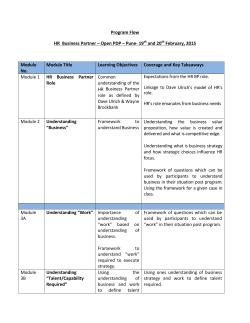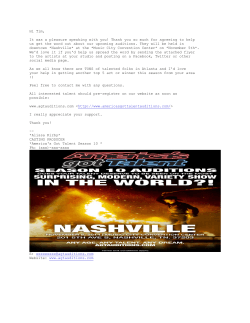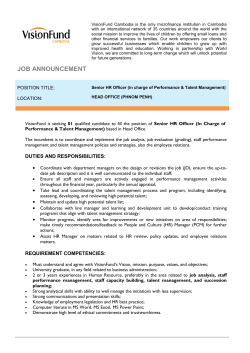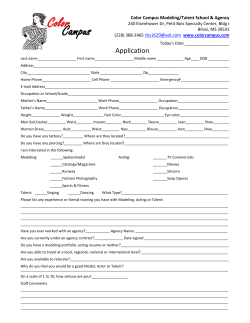
Objective and strategic talent management â approaches
Romanian Journal of Cognitive Behavioral Therapy and Hypnosis Volume 2, Issue 1, January – March 2015 Theoretical Paper Objective and strategic talent management – approaches to increasing human resources results Petru Mihai Craiovan Titu Maiorescu University, Bucharest, Romania Abstract The human resources are an essential component of the organizational activity, component whose contribution and functioning may determine whether success is obtained or not. Talent management is a highly debated subject of the human resources field, but research has approached it only recently, raising the need of offering stronger conceptual delimitations, means of identifying criteria for the connection between talent and organizational success, providing strong methodology in assessing talent. Also, discussions are held related to whether talent management refers implies development of selection policies or strategies of increasing the possibility of employees to obtain higher positions within the company and even remaining stable elements of the organization. The present article proposes to contribute to the academic debates regarding talent management both as a concept and a process integrated within human resources strategies. Keywords: Talent management, human resources, organizations, professional environments, career decisions, leadership potential Corresponding author: Petru Mihai Craiovan Phone number: E-mail address: psihologie@utm.ro RJCBTH 1 Craiovan, P. M. I. INTRODUCTION Although talent can be described as a valuable, rare and unique result of potential it seems that the issue of drawing concrete measurable expectations to be followed by organizations is a matter only recently approached in research literature (Lewis, Heckman, 2006) – aspects which might serve as valuable criteria in developing talent management policies and strategies. Maltais (2012) views effective talent management as a factor which makes the difference between high performing organizations and others, as identifying talent among employees is considered as supporting towards innovation, empowering the brand recognition and also as criteria which leads to providing a good work environment. The contribution of talent management policies is not the only reason why it should be approached by research. There is also series of rather practical reasons as discussed by Athey & Burnside (2007) who show that the number of medium and high education graduates has decreased, along with other aspects such as workplace satisfaction of employees – on the other hand the complexity of requests within companies tends to be higher. Therefore, the need of selecting the best candidates and making sure they are involved on a long term basis with the company’s interests and objectives seems to be bigger than ever (Spencer & Spencer, 2008). Overall these are arguments for the need of employers to involve and maintain persons who best suit their business activity. Athey and Burnside also emphasize the fact that employees not only seek well paid workplaces but also the possibly of obtaining personal and professional development is an important factor for their involvement and career choice (Athey & Burnside, 2007). 1. Understanding the concept of talent management We may view talent management as a process which includes all human resources processes applied with consideration to the employees potential and adapting it to the organizational requests through concrete actions which include performance management, analysis, planning and making decisions regarding organizational succession, personnel selection and recruiting, developing knowledge, ability and individual career paths, as defined by Farley (2005). Although this seems to be a common conception of talent management we should consider the fact that due to its relatively new entrance in the area of interest of academic researchers (e.g. Dries, Cotton, Bagdadli, 2014; Lewis, Heckman, 2006) talent management is presented both in practical and theoretical publications from different points of view. In this prospect, Lewis and Heckman (2006) provide a strong critical review of the concept drawing the attention to the fact that many of the descriptions of talent management do not offer a RJCBTH 2 Talent management & human resources clear distinction from general activities conducted by Human Resources specialists – whether we refer to selecting the best candidates, developing the potential of existing employees or planning organizational succession and providing viable rewarding strategies. Some authors (Hambrick, 2007; Bagozzi & Phillips, 1982) explain this fact through the lack of theories and methodologies able to offer causal models and superior foundations. In 2014 Dries, Cotton, Bagdadli and de Oliveira synthesize the main tendencies in approaching talent management. One of them refers to the emphasize placed whether on „selection” or „development” according to which most of the companies base their decisions on the idea that talent is inborn – therefore talent management should sight identifying natural potential through the phase of personnel selection. The authors show implications of such an approach such as the tendency of managers to label employees as „talented” or „non-talented” from their first steps within the organization making it difficult for them to observe improvements or specific abilities later on and also differences in managing policies as some consider identification of potential to be essential for their business and other – growing potential as employees are already hired. The second implication comes, according Dries et al. (2014), with the cost of providing additional resources for the employees such as professional training programs. This point of view is also supported by other authors (e.g. Stahl et al., 2011, quoted by Al Ariss, 2014) who provide proof of such tendencies based on data obtained from 33 multinational organizations; thus, talent management can be applied in a differential manner – sighting emphasize on differentiating specific resources of employees and assigning them hierarchically – or inclusively – based on individual potential. McDonnell, Lamare, Gunnigle and Lavelle (2010) also bring to discussion a similar difference in approach as they identify two types of employee groups which are targeted by talent management strategies. They refer to internal development – based on knowledge which sights the contribution of employees in reaching organizational objectives – as they have more chances of developing internally due to their knowledge and abilities needed in specific departments and the development of future leaders, namely, according to the authors, those few employees which show the highest potential and performance and reach the criteria of uniqueness. Another observation brought to discussion by Dries et al. (2014) suggests differences within professional environments in embracing standardized evaluation of personnel compared to the subjective manner of concluding whether a person shows talent or not. Thus, they bring the argument of Tulgan, 2001 (quoted by Dries et al., 2014) according to whom it seems that many human resources practitioners tend to underestimate the importance of applying scientifically validated means of evaluation in identifying talent and formulating RJCBTH 3 Craiovan, P. M. development plans, means such as psychometric tests, structured interviews and inclusion of employees within assessment center. 2. Including a strategic approach of talent management within Human Resources policies Authors such as Al Ariss (2014) suggest that each company should formulate its own specific talent management policies according to identified needs and not according to a predefined method adopted by other organizations. The recommendation is also supported by Preziosi (2008) and Maltais (2012) who indicate that a talent management strategy cannot be one of universal, general nature as each company requires the development of a personalized plan which should respect its specific domain of activity and size. Other authors (McDonnell, Lamare, Gunnigle and Lavelle, 2010) stress the importance of identifying the key positions within organizations which might offer an advantage from the point of view of sustainability and offering the possibility of the best employees to occupy such positions. Also, Maltais (2012) stresses that talent management strategies planning should be a priority among other business – related issues and that organizations should be able to obtain and use data during any given stage of the talent management process in order to identify the extent in which such an investment is a profitable one. Considering such amendments, the following section provides several guidelines to serve the development of talent management policies. Farley (2005) insists on the importance of a strong collaboration between management units of the company and human resources agents who together should be able to formulate the most important goals and objectives of the company along with clearly tracing expected results, hence providing the identification of the best strategies of utilizing the employees’ potential. According to the same author, such objectives and expected results will be converted into competences needed to support the successful activity of the company. Similar approaches are supported by other authors as well, such as Maltais (2012). Athey & Burnside (2007) provide several directions for the successful approach of talent management. We may notice that their recommendations mostly have the objective of facilitating communication between employees; indifferent from their hierarchic positions in order to cultivate the perception of the newbies that their future career paths are important to the company but also to encourage leaders and more experienced personnel to share experience and knowledge. RJCBTH 4 Talent management & human resources Hence, the discussed steps consist in: the strategic integration of the newbie sighting their active support establishing relationships between then and the leaders and exchanging knowledge regarding the organization and its values; providing coaching programs to enable employees to receive personalized guidance regarding their best suited career decisions; encouraging productive conversations among employees both formally and informally; creating physical space stimulating and differentiated for each type of activity conducted by the employees; encouraging leaders to validate the selection of tasks considered as suitable by each employee in spite of valuing extra hours and alert work rhythm which might increase stress among them. Hoffman (2010) obtained, based on the company’s approach, a model (“TRY ABCD First”) based on several key elements such as: communicating values, expectations and company strategy to the personnel and encouraging leaders to teach them to the people they work with; identification and understanding of the roles critical to the business’ success; concentrating strong resources to evaluating leadership potential, monitoring and continuously developing management abilities (in spite of considering them to be inherent); positioning continuous learning as an imperative, an objective of the business itself; making a priority of the client’s needs. III. CONCLUSIONS AND FUTURE PROSPECTS Among the most important aspects of including talent management strategies within the human resources processes we may identify the mandatory request of collaboration with the general managing actors who, together with the HR specialists, should draw the main objectives and expected results relevant for their companies but also in deciding whether talent management is a matter of selection of personnel professional development. We support the latter option along with increasing the openness towards focusing on improving hierarchical communication between employees in order to increase the perception of the newbies upon their career perspectives. On the other hand, not only human resources practitioners are concerned with talent management. In 2006, authors such as Lewis and Heckman brought strong arguments to the need of research to sight the distinction between investing in talent management method applied through human resources practices and processes and the need of selectively investing in talent by focusing on specific aspects in spite of the need of developing talent on a general level. Thus, identifying the most relevant criteria of the talent for the organization, the level up to which it should manifest and the set of practices needed to support performance are aspects which need further attention from researchers (Tarique & Schuler, 2010; Delaney & Huselid, 1996). RJCBTH 5 Craiovan, P. M. Also research should sight the identification of analysis methods to support talent management decision making but also support widening the openness of human resources practitioners towards evidence - based methodology. References Al Ariss, A. (Ed.). (2014). Global Talent Management: Challenges, Strategies, and Opportunities. Springer Science & Business. Athey, R., & Burnside, R. (2007). In focus/talent management—Engaging and developing is key to the challenge. Leadership in Action, 27(4), 19-21. Bagozzi, R. P., & Phillips, L. W. (1982). Representing and testing organizational theories: A holistic construal. Administrative Science Quarterly, 459-489. Delaney, J. T., & Huselid, M. A. (1996). The impact of human resource management practices on perceptions of organizational performance. Academy of Management journal, 39(4), 949-969. Dries, N., Cotton, R. D., Bagdadli, S., & de Oliveira, M. Z. (2014). HR Directors’ Understanding of ‘Talent’: A Cross-Cultural Study. In Global Talent Management (pp. 15-28). Springer International Publishing. Farley, C. (2005). HR's role in talent management and driving business results. Employment Relations Today, 32(1), 55-61. Hambrick, D. C. (2007). The field of management's devotion to theory: Too much of a good thing?. Academy of Management Journal, 50(6), 1346-1352. Hoffman, R. (2010). Talent management at Novartis Oncology: Supporting a decade of success. Global Business and Organizational Excellence, 30(1), 29-39. Lewis, R. E., & Heckman, R. J. (2006). Talent management: A critical review. Human resource management review, 16(2), 139-154. Maltais, D. (2012). Take a coordinated approach to talent‐management strategies and solutions. Employment Relations Today, 39(2), 47-54. McDonnell, A., Lamare, R., Gunnigle, P., & Lavelle, J. (2010). Developing tomorrow's leaders—Evidence of global talent management in multinational enterprises. Journal of World Business, 45(2), 150160. Preziosi, R. C. (2008). Using talent‐management audits can improve HR's results. Employment Relations Today, 35(3), 17-24. Spencer, L. M., & Spencer, P. S. M. (2008). Competence at Work models for superior performance. John Wiley & Sons. RJCBTH 6 Talent management & human resources Tarique, I., & Schuler, R. S. (2010). Global talent management: Literature review, integrative framework, and suggestions for further research. Journal of world business, 45(2), 122-133. Vaiman, V., Scullion, H., & Collings, D. (2012). Talent management decision making. Management Decision, 50(5), 925-941. RJCBTH 7
© Copyright 2025









